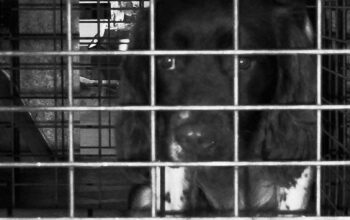Crate stress is real with boarding kennels! Dogs become stress ridden the same way as you and I and putting your dog into boarding kennels can be very stressful for them. Imagine that you would take a young child to a strange place and leave it with people it doesn’t know. The child will become distressed and angry more often than not. The same can happen to dogs and does to humans.
Even steady dogs can become stressed when faced with new surroundings, changing diet and routines. It is the ideal for a dog to be surrounded by strange smells and other dogs, some of which might barking in a kennel they are unfamiliar with.
Owners often don’t realize or never come to them that their dog may become stressed under these conditions, particularly if signs of stress aren’t observed in their home environment or when they are out and about. A boarding kennel environment can be particularly tough on scary, fearful, anxious or aggressive dogs. It can be hard for dogs from the same family if they are not used to being separated, alone or away from their owner. Some dogs who have never been previously in a kennel in their life found kenneling very restrictive. There are then some dogs who just need more room than others. – In dogs, separation related issues are on the rise and do impact on a dog’s behavior.
Many kennels these days and I do the same thing; ask if your dog has been previously boarding in kennels if not day / night stays are recommended. In the beginning you first need to assess the condition of your dog, even if you are not going away, introduce your dog to a boarding kennel environment. Dogs need to have good experiences again, a bad experience can affect their behavior.
Kennel stress symptoms can manifest in dogs in many ways:
- Aggression: often due to fear, the dog cannot be handled by anyone other than the owner (may need a few brief visits to get your dog used to being handled by someone else)
- Barking: it is a sign the dog is distressed and is also very unsettling for the other dogs
- Hunger (Limitation of Appetite): not eating due to stress or change in diet Dietary change can also cause vomiting and diarrhea
- Constant kissing of the lips : dogs do this to try and calm themselves down.
- Pacing & Depression: Some dogs who have never been confined before may attempt to break out by tearing themselves out of the kennel walls or doors.
What can be done to make the stay of your dog less stressful and more enjoyable for you the owner.
- Your dog must have training to go into kennels. Day stays in a boarding kennel are a good way to get your dog used to it. Use it if you have a kennel and drive it at home or some other form of containment, such as a garage, small room or a dog crate.
- If you are a multi-dog household, make sure that your dogs are independently of each other and can cope on their own. Separate kenneling or confinement is helpful in helping out. Doesn’t mean they can’t hangout together ; simply means they are comfortable being alone. The same applies to dogs that are too attached to their owner – they also need to be independent.
- Visit kennels, speak to the owner of a kennel, are they knowledgeable and friendly, and do they understand dogs and dog behavior. Just because they run a boarding house doesn’t mean they understand dogs and dog behavior.
- If you have a nervy, anxious or aggressive dog or a dog who is simply needing some space. Ask whether the kennel owner is experienced in handling such breeds of dogs and can accommodate them.
- It may take a bit longer for these dogs to be introduced into kennels by the owner and the boarding kennel owner. Some kennels may not take them because they are not properly configured to do so. Likewise certain breeds of dogs may not be welcomed.
- Ask to bring in a blanket or play to your dog to make it less stressful and more comfortable.
- Ask how your dog will be exercised; some kennels walk the dogs while others let them out to run with other dogs in large premises.
If they are allowed to run with other dogs, ask if they are supervised, that is, is there someone physically present “standing and monitorin” the dogs while exercised.
Even friendly dogs can fall out and a dog fight may ensue, also signs of stress, distress, bullying, it is important that someone is standing there, looking at the whole time, with their eyes wide open.
Also, ask if they regularly move small and large dogs together in groups. They are both to have their own exercise, not combined as small / big dogs should not be exercised. Some large dogs may regard small dogs as potential prey and so there is a possibility that they may chase and kill them.
Be aware that some kennels leave the dog – ran together unsupervised. In other words, nobody is always watching them while they are out running around.
Also do not just ask if the dogs are supervised while running together ; ask if “someone is physically present”, all the time while the dogs are being exercised.
Also read the kennel contract before signing it. Most say they are not liable for anything your dog experiences while in kennels. This is fair enough because they are running a business but the risk can be reduced if someone watches with their eyes wide open for signs of stress, aggression, etc if dogs are allowed to run in groups.
After all, when owners of dogs and cats put their pets in these establishments for that matter, they trust that they have their pets best interests at heart.
If your dog is anxious or nervous, a dog that has aggressive, or just needs some space, ask whether your dog can be exercised separately.If your dog is anxious or nervy, read tips for boarding anxious/nervy dogs.
If your dog is on a special diet or needs medication ask if the kennel will feed the diet needed or provides medication.
Ask if you can bring in your own dogs food to keep its diet the same also.



